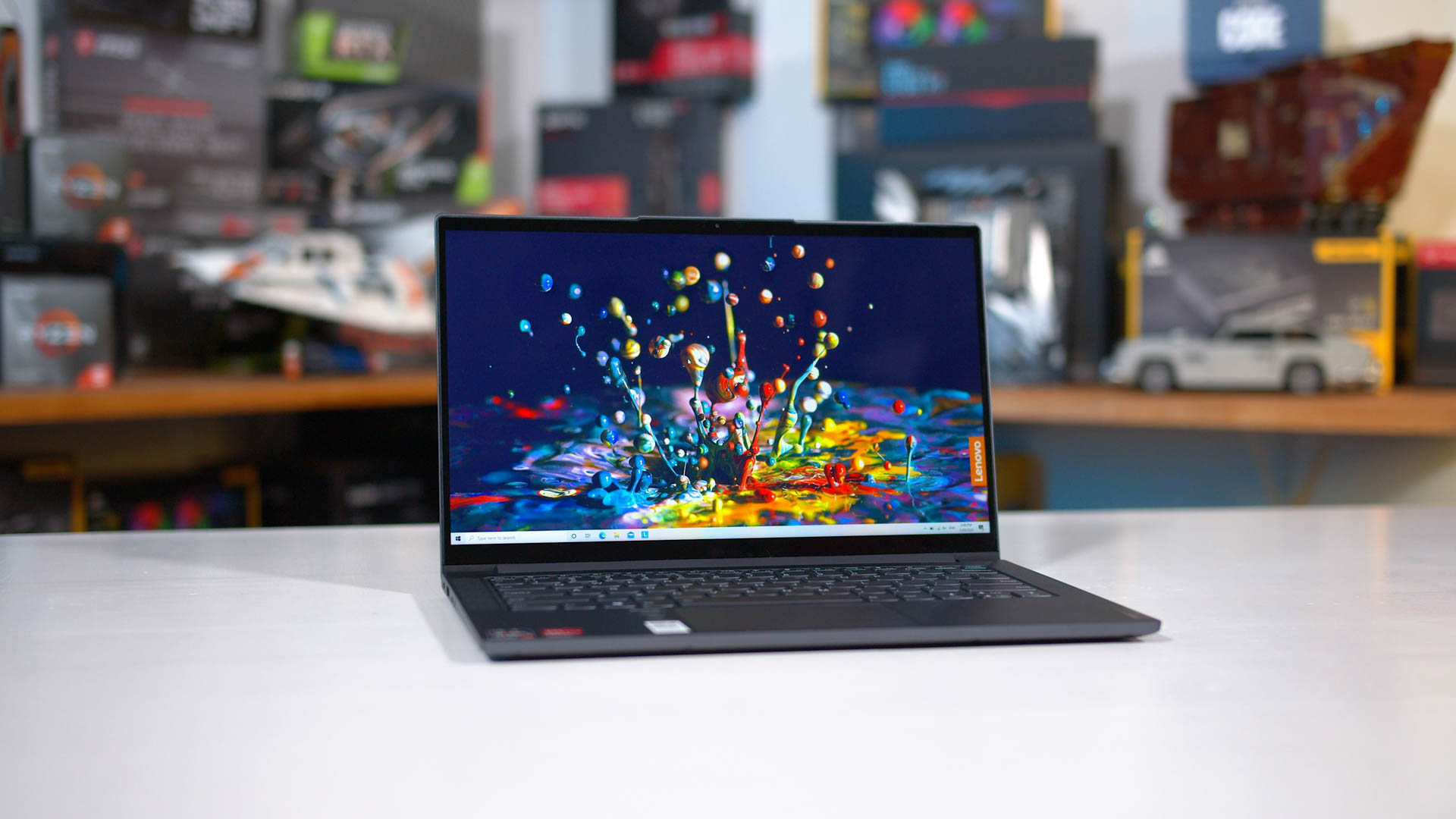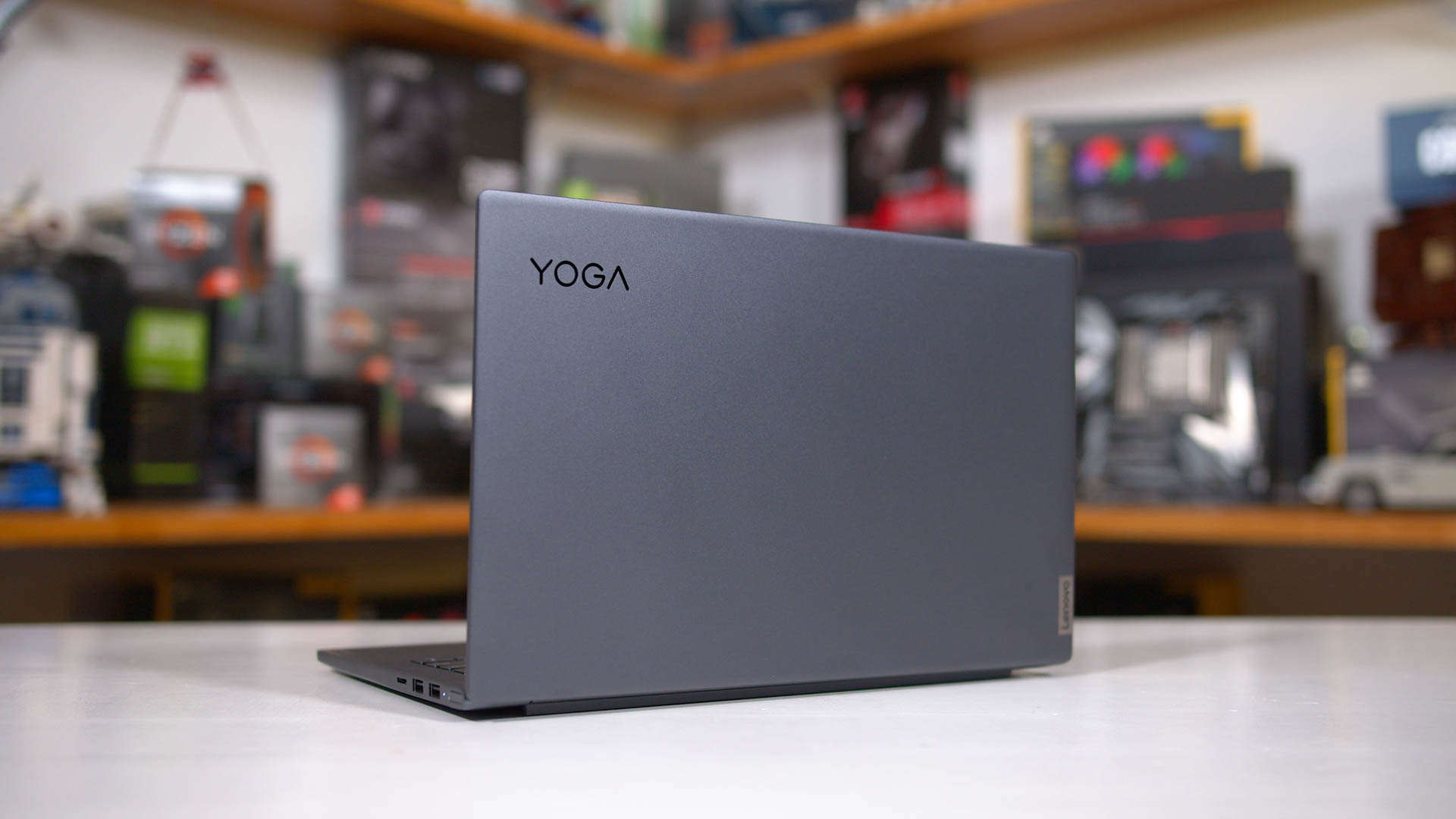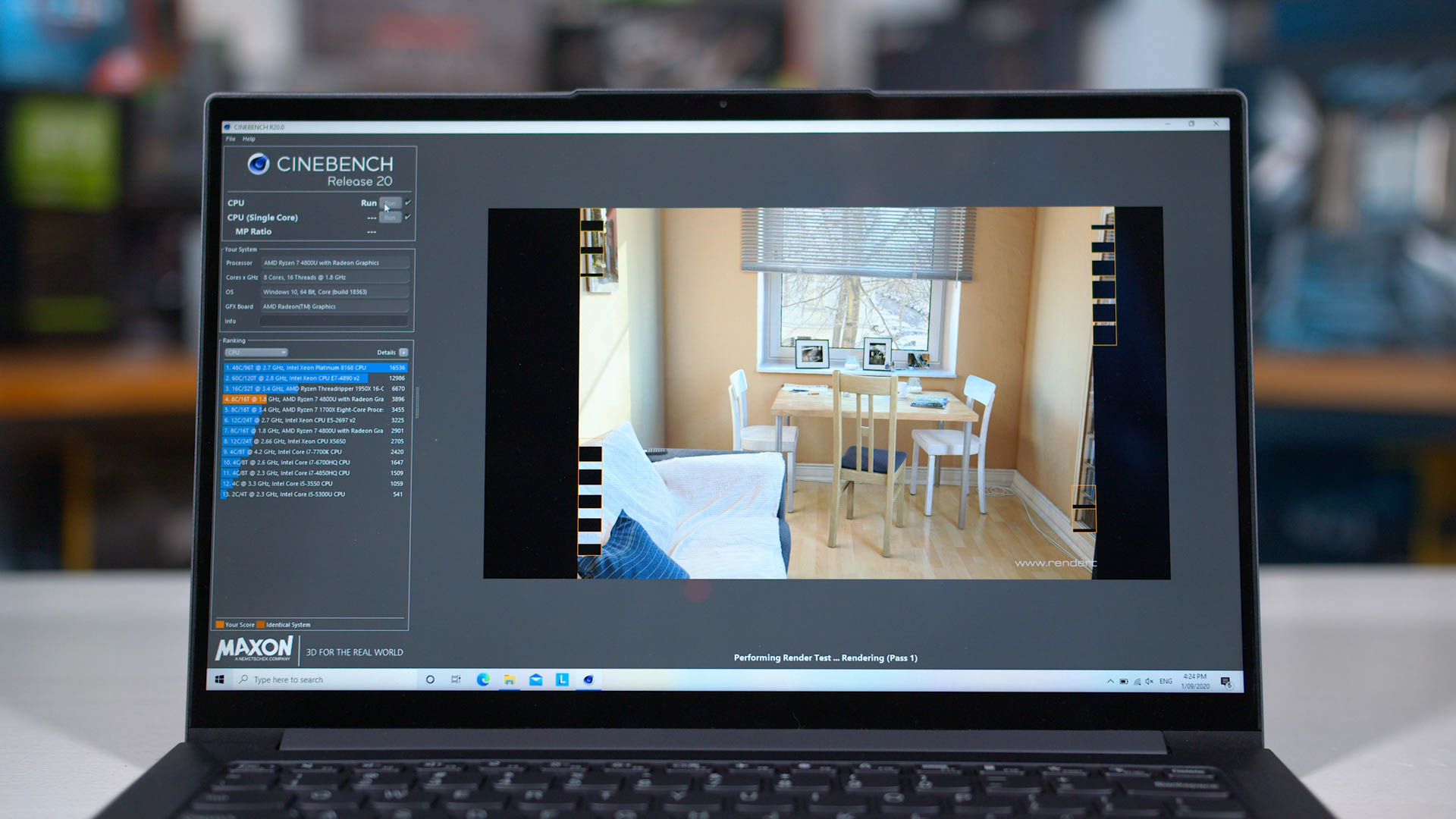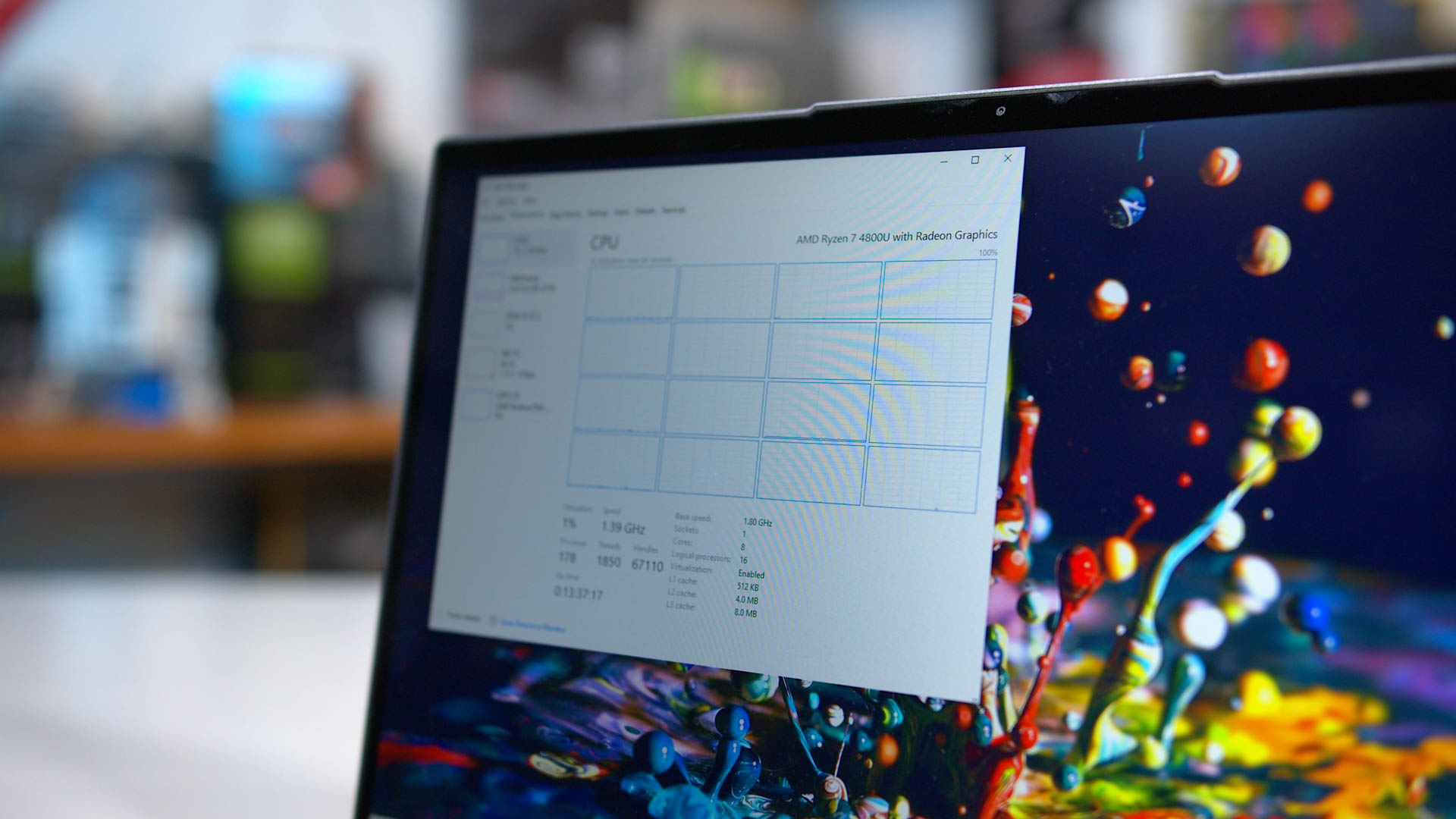AMD Ryzen 7 4800U Review
Today'due south review is all about the Ryzen seven 4800U, AMD's acme-of-the-line APU for lightweight laptops, also known as ultrabooks. This is the best Renoir die AMD has to offer from an efficiency standpoint, aiming to bring the corking functioning to 15W and 25W power envelopes.
Since the launch of the Ryzen Mobile 4000 series, the original plan was test U-series parts shortly later that, but delays striking nearly product launches and only now PC makers are starting to ship Ryzen ultraportables in serious volume.
We already know how well Zen ii scales up to higher TDPs in the H-series -- parts such as the Ryzen 7 4800H -- merely how this applies to ultraportables has remained unclear.

First let's apace epitomize about specifications: the Ryzen 7 4800U uses a fully unlocked die, with viii CPU cores agile, and 16 threads. We're getting 8MB of L3 cache and clock speeds upward to four.2 GHz in a low-thread boost state. The base of operations clock of i.8 GHz is lower than other parts, equally AMD needs to fit 8 cores into a 15W TDP rating.
The GPU is fully unlocked likewise, and so nosotros see viii Vega compute units enabled with clock speeds upward to 1750 MHz. 8 Vega CUs ways 512 shaders, a reduction on terminal generation Ryzen parts, only compensated for with higher clocks. The entire bit is a monolithic die built on TSMC's 7nm engineering and the CPU cores are based on the Zen two compages.

The simply real departure betwixt the 4800U and the Ryzen 7 4800H (for workstation and gaming laptops) is the power limit and clock speeds. The 4800H has a base of operations clock of 2.9 GHz for case, and can sustain higher frequencies. But outside of that, the 4800U and 4800H are based on the same silicon.
The test system for today's review is the Lenovo IdeaPad Slim 7, a premium 14-inch ultraportable that has a really dainty metal chassis and overall build quality. Like most of our component reviews, this isn't a review of the laptop itself, but in our short time with it we've been impressed. This is not the instance of "OEM puts Ryzen in a mid-range organization" situation, but we see the IdeaPad rivalling the best out at that place in its segment.

The 4800U is coupled with 16GB of LPDDR4X memory in a dual-channel configuration. Ryzen supports both DDR4-3200 and LPDDR4X-4266, our previous testing has been with DDR4 configurations, this laptop gets the full LPDDR4X handling. There's also a adept quality 1080p display, 512GB of PCIe storage and a 60 Wh battery. Final pricing for this configuration is non however bachelor just we'd look it to be around the $one thousand marking.
Similar all of our laptop testing, nosotros are sticking to stock power configurations where possible, which allows for an apples-to-apples performance comparison where laptops' cooling and power settings shouldn't impact results as much. For today's testing we'll be looking at performance with long term power limits of 15W and 25W.

In reality, the IdeaPad Slim seven can sustain in a higher place 25W for quite some fourth dimension in its maximum power mode, which is an impressive feat for this sort of laptop. But again, to keep everything equal we'll be looking at 15W and 25W performance.
That said, both modes we're testing all the same have strong boost behavior, in keeping with how most Ryzen laptops that we've tested actually operate. This ways a boost level up to 35W or so for effectually five minutes at 25W, and ii.v minutes at 15W. This is a longer boost catamenia than Intel'south U-series processors this generation. It is clear AMD intends to button boost for equally long equally is feasible to evangelize maximum performance.
Benchmarks
Before we begin, and as yous're likely familiar with, all our benchmark charts average the results from laptops using in the same configuration, the full list of laptops we tested are here.
Allow'due south first with Cinebench R20. At 15W, the Ryzen 7 4800U is incredibly fast. We're seeing performance that matches the Ryzen 5 4600H, a six-core 45W SKU, while outperforming Intel's 45W parts such as the Core i7-10875H in the multi-thread test. This is admittedly insane levels of functioning, allowing the 4800U to evangelize workstation-like results at just 15W.

It also means the Ryzen 7 4800U demolishes every Intel U-series part in the charts.
The 4800U at 15W is over 150% faster than the Cadre i7-1065G7, Intel's all-time Ice Lake processor. Granted, the 1065G7 has just four cores. AMD's decision to enable eight-cadre designs in a laptop form factor has paid off here. Nosotros're besides seeing double the performance of the best Comet Lake CPU, the six-cadre Core i7-10710U.
The margins are a little narrower at 25W: the 4800U is still 130% faster than Ice Lake, and 70% faster than Comet Lake. These are margins that are practically unheard of in mobile computing and surely telephone call for Tiger Lake to remedy this situation for Intel.
AMD is too able to universally hold the Cinebench R20 single-thread performance crown in the U-series market. Margins aren't anywhere near what they are for multi-thread, but we're seeing up to a 10% lead on the i7-1065G7 and 15% on the i7-10710U.

Functioning is also remarkably impressive in some of our longer workloads, like Handbrake, which takes at to the lowest degree one-half an hour to encode our x265 sample video. The 15W 4800U is offer close to the performance of Intel's Core i7-10875H, while at 25W, it beats the overall fastest CPU Intel has in their unabridged mobile line-up, the Core i9-10980HK.
The 4800U is an H-serial sort of CPU in terms of performance, or at least completely redefining what we should expect out of the U-series.
The 4800U is over twice as fast every bit the Core i7-1065G7 at both 15W and 25W. Meanwhile, we're seeing at least 70% better performance than the Core i7-10710U, with an 88% lead at 15W.

Similar story with Blender. Now Intel would tell y'all this isn't a "existent world" benchmark as yous wouldn't run Blender on an ultraportable laptop. But with the performance AMD is offering here, I think that needs to be reconsidered.
You definitely wouldn't want to use Blender on a Cadre i7-1065G7 laptop, but the 4800U offers well over twice the performance.
GPU acceleration nonetheless makes H-series laptops attractive for workloads like this but equally a highly portable workstation APU, the 4800U makes for a compelling option.

When compiling Chromium, the 4800U is about 70% faster than the Core i7-1065G7 whether you test in a 15W or 25W configuration. In fact, the 4800U is just as fast at 25W, as a Core i7-10875H at 45W. Like margins for GCC compilation, Ryzen is merely much faster for coding.

Looking at some lighter productivity workloads now, which is perhaps more of import for a thing and light organization. In our Microsoft Excel number crunching criterion, Ryzen still holds a huge performance atomic number 82 on Intel's Water ice Lake processors.
We aren't quite in H-serial territory with the 4800U here, but we do go shut and certainly this is the fastest 15W CPU on the marketplace.


For PCMark ten'southward productivity exam, which is lightly-threaded, the results we saw in Cinebench R20 unmarried-thread come to play. The 4800U is 12% faster in this benchmark than the Cadre i7-1065G7, which is really a best case scenario for Intel'southward U-series. And these margins carry over into the Essentials exam, which covers web browsing and app loading, bones tasks you'd run on a laptop. The 4800U is a double digit pct faster, up to 15% when compared to something like the Core i7-10710U.

In MATLAB, in that location's not much separating U-series processors, so whether yous choose Intel or AMD, it doesn't make much of a deviation with the latest version. The functioning you meet here will heavily depend on what functions you're running, single threaded or retention express stuff is close betwixt both platforms.

In 7-Aught, the 4800U gets shut to AMD'southward 45W APUs like the Ryzen seven 4800H. The 4800U is much faster for decompression than any other U-series role, including AMD'due south lower core count processors like the Ryzen v Pro 4650U and especially the 4500U.
The margins compared to Intel are very high, over two.5x the performance for decompression compared to the 1065G7, and over 60% faster for compression.

In Acrobat PDF exporting, which is entirely single-threaded, the divergence between the 4800U and Intel's U-series processors is within the margin of fault. In this test which has historically been fell on AMD APUs, in that location is no difference in functioning.

The Adobe suite continues to be somewhat problematic for Ryzen Mobile, as seen in these Photoshop results. While the 4800U is competitive, especially at 15W, the Core i7-1065G7 is marginally faster when it's allowed to button up to 25W.
The difference isn't massive, the 4800U is ~4% backside, but you also take to gene in that apps like Premiere take better compatibility and characteristic support on Intel. There are still problems with color grading 4K videos in Premiere on the Ryzen 7 4800U, which need to be resolved before an APU-only AMD-powered laptop is suitable in that app.

Then for something like DaVinci Resolve, we are only including this due to popular demand.
While the 4800U is faster than a Core i7-1065G7 in this workload because the app uses the GPU heavily, yous are far amend off with a laptop that includes a more than powerful discrete GPU. Fifty-fifty something like the 1650 Ti Max-Q is a lot faster.
Gaming Tests
That's not to say the Ryzen 7 4800U has a useless integrated GPU. For light gaming, it's more than competent than you might expect. In GTA V for example, you tin can accomplish a solid 60 FPS experience using the lowest settings at native 1080p, with just 15W of APU ability. This is a big footstep upwardly on the Core i7-1065G7 at the same ability level.

The 4800U is perfectly suited for games like Civilization 6, with enough GPU horsepower to evangelize well above lx FPS using the lowest settings.

The CPU is besides reasonably fast for things like plow times, and while it'due south not going to be as nice of an experience equally on a proper gaming organisation, strategy games are some of the best to run on Ryzen laptops.

CS: Get is as well a adept feel on the Ryzen seven 4800U. At native 1080p and using competitive settings, the 4800U delivers over 100 FPS average. At 25W, performance is similar to the 1065G7, but at 15W, information technology'due south faster. You can also run into here the 4800U beating the MX250 configuration easily.
I of the near interesting benchmarks is Gears 5, which is a await at a GPU enervating game running at medium settings. The Ryzen seven 4800U is the fastest iGPU in this benchmark delivering 24 FPS.
While that's too dull for actual gaming using those settings, it does suggest the game is playable at lower settings or when using the dynamic resolution mode. In our experience you lot can get to a higher place xxx FPS with a few more than things turned downwardly, which is non as possible on other depression-power processors.

The 4800U at 15W is also able to friction match the combination of a 15W i7-1065G7 with the 10W MX250. This suggests that overall, the 4800U's 8 Vega CUs is a more efficient gaming platform than the combination of an Intel CPU with a discrete GPU. You lot'll too run across the functioning difference between the 4800U and Ryzen APUs that have simply six compute units at lower clocks: the 4800U is 25% faster at 15W.
And finally there are some interesting things to run across between the various ability configurations. Ryzen 5 APUs with that six-CU GPU don't benefit much from the increased power limit, going from 15W to 25W. However the 4800U does, in this test nosotros saw a modest 12% proceeds. Ice Lake gains the most, it saw upwardly to a 35% increase with the actress power available to it.

Similar results can be seen in F1 2022 running at the ultra low preset. The 4800U delivers a playable experience in this title for an integrated GPU, with a 1% low to a higher place 30 FPS. Meanwhile, the MX250 is barely a 30 FPS sort of experience, while Water ice Lake at 15W is not able to continue upward. The 4800U is 56% faster than the 1065G7 in this game at 15W.
Performance Breakdown
When putting the Ryzen 7 4800U upwardly against the Cadre i7-1065G7 at the same 15W power level, the Ryzen APU is virtually ever faster. In multi-thread workloads that margin is significant, it'due south reasonable to wait more than double the performance. But even in most unmarried-thread tests, the 4800U holds a narrow margin.

Being over ten% faster in PCMark's Productivity and Essentials tests is a strong result given these are common U-series tasks.

At 25W, the margins do narrow between Renoir and Ice Lake, but not past enough to modify much.
Ryzen is still more than than twice as fast in some multi-thread workloads, and generally faster at single-thread, as well. Combined with a faster integrated GPU, the 4800U is more often than not anywhere from a flake faster, to much faster for typical laptop tasks.

Intel too has Comet Lake U-series designs with up to six-cores, for heavier multi-thread productivity. But AMD is able to beat this part, too, with more than than 80% amend functioning in longer term multi-thread workloads. The Ryzen 7 4800U also has a much faster integrated GPU, around 2.5x faster than Intel'southward dated Skylake-era blueprint, and then the 4800U is a more complete performance packet.

Compared to AMD'southward own line-up, the Ryzen 7 4800U is notably faster than the Ryzen five Pro 4650U. The jump from 6 to 8 cores, fifty-fifty in the aforementioned power envelope, allows for x to 30 percent more functioning in typical tasks. This is because adding more cores and running them at a lower frequency tends to be a more efficient design, particularly at these core counts.
The small 200 MHz increment to boost clocks likewise delivers better single-thread performance, with the 4800U able to striking four.ii GHz on a unmarried core below 15W of power consumption. In fact, single-core power usage for the entire APU is more than similar 12W, very impressive stuff.

Depending on your use, there's besides reason to upgrade your laptop configuration from a Ryzen v 4500U to a Ryzen 7 4800U during the purchase process. The 4800U is at least x per centum faster for basic productivity, just upward to 50% faster or more in multi-thread heavy workloads.
The combination of 2 extra cores and having SMT enabled is a significant improvement for Renoir.
There was in one case a time when, for example, there wasn't much of an comeback between a Core i5 or Cadre i7 configuration. Just here, AMD in their Ryzen 7 tier are producing a strong upgrade incentive.


We want to close with some H-serial comparisons. At 25W, the Ryzen 7 4800U is generally faster than the Ryzen 5 4600H, which is impressive and goes to show how efficient this Zen 2 APU is at low ability levels.
The 4800U is also able to trade blows with the Core i9-10980HK. Information technology doesn't always win, but margins are typically beneath xv% either way which is crazy considering the Core i9 function is the best in Intel's entire mobile line-up, at to the lowest degree until Tiger Lake arrives.
What We Learned
The Ryzen 7 4800U is i of the most impressive products we've e'er tested, both winning its market segment, and providing a huge gen-on-gen operation leap.
There are a number of angles as to why the 4800U is so remarkable. The big one is that it destroys Intel's Ice Lake and Comet Lake processors. Information technology'due south not unusual to come across double the multi-thread performance, or ameliorate, while also winning the single-thread battle. Throw in an integrated GPU that can exist 50% faster, especially at 15W, and the Ryzen 7 4800U wins in all 3 major categories for an ultraportable CPU.
If this was a 100m sprint, you'd retrieve the 4800U is cheating with performance enhancing drugs, that's how much it beats its direct opponent by.
The types of margins we're seeing hither highlight the efficiency of AMD'southward Zen 2 design and TSMC's 7nm procedure node. On the desktop, Intel tin can still be competitive by increasing power consumption to lucifer what AMD is doing with Zen ii. That's only not feasible in power and cooling constrained laptop form factors.

We went back and looked at how many generations information technology took for Intel to double U-serial performance. Based on Cinebench R15 multi-thread results, the Core i7-1065G7 is roughly twice equally fast equally the dual-cadre Core i7-5600U from the Broadwell generation. So it took Intel well-nigh four years to double the performance on offer. Achieving this on a single generation is unheard of in the CPU market, although to be fair AMD has been struggling long enough to penetrate the laptop market that it was about time they delivered since they've had really expert CPUs for desktop systems for years now.
With all this extra functioning, in exercise the Ryzen 7 4800U redefines what an ultraportable laptop is capable of. Previously, you probably wouldn't have wanted to do any meaning data crunching or code compilation on an ultraportable, however moving frontwards this is the bar Intel (and notably ARM-based MacBooks) will have to overcome.

The 4800U competes with H-serial laptops to an extent, oft getting shut or beating Intel's current offerings similar the Core i7-10750H. If you typically utilise your laptop for CPU heavy tasks, why bother with a 15-inch 5 pound system with limited battery life when a lightweight 13- or xiv-inch system can offer the same level of performance?
Of form, the 4800U and other U-series processors can't fully supercede what H-series designs offer. Ryzen H-series parts are nevertheless faster and and so in that location'south the whole detached GPU situation. thirteen-inch designs aren't getting 80W GPUs any time shortly, and that'southward where a larger laptop tin can pull ahead.

Intel Tiger Lake CPUs are set to get in soon which volition put the company back in contention, but with such dominant functioning from AMD, Tiger Lake will probable be more than near communicable up to Ryzen on this generation. Meanwhile, AMD is already thinking about Zen 3, which isn't too far away.
It's an exciting time for laptop performance, we finally have serious competition and that'due south going to advance this market like we haven't seen in years. Tiger Lake laptops are but around the corner, more Ryzen 4000-based models including ultraportables, and let's not forget that Apple tree is coming upwards with their own (potentially devastating) ARM-based SoC for MacBooks too.
Nosotros'll soon encounter how the market is shaping upwardly for the holiday season. And of form, we'll go along on benchmarking.
Shopping Shortcuts
- Lenovo IdeaPad Slim vii on Amazon, Lenovo
- Ryzen 7 4800U Laptops on Amazon
- Ryzen v 4500U Laptops on Amazon
- Ryzen 7 4800H Laptops on Amazon
- Ryzen 9 4900HS Laptops on Amazon
Source: https://www.techspot.com/review/2096-amd-ryzen-4800u/
Posted by: bandyberful.blogspot.com


0 Response to "AMD Ryzen 7 4800U Review"
Post a Comment